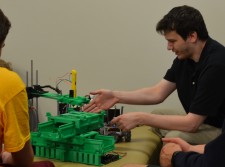NDSU Students Develop 3D Printing Self-Replicating Robot

FARGO, N.D., July 19, 2017 (Newswire.com) - A team of students at the North Dakota State University have completed a key step in the development of a robot that is able to make a replica of itself. Self-replicating robots are key to a long-duration exploration of other planets. They also have numerous industrial, military and other uses.
The team has developed and completed the initial testing of a 3D printed 3D printer. This unit is of particular interest, as it was designed to be modular so that the individual pieces can be produced by the printer. Thus, it is able to replicate all of the structural parts needed to make a copy of itself.
The potential exploration and other uses of self-replicating robots are significant. With the use of in-situ materials, there is a potential to make numerous copies of an initial set of robots and greatly expand the work-performance capabilities of the robotic team. Replacement parts can also be produced to return damaged units to service.
Jeremy Straub, Assistant Professor, NDSU Computer Science
“The potential exploration and other uses of self-replicating robots are significant,” commented NDSU Assistant Professor of Computer Science Jeremy Straub, who is overseeing the project. “With the use of in-situ materials, there is a potential to make numerous copies of an initial set of robots and greatly expand the work-performance capabilities of the robotic team. Replacement parts can also be produced to return damaged units to service.”
By producing robots in-situ, materials brought to a planet for exploration or a region of Earth for military or exploration use can go much further, producing ten times or more units, as compared to shipping ready-to-use units. The current design utilizes metal and electronic components that cannot be produced in-situ. A long-term goal of the project is to minimize the number of components that must be externally supplied and limit how many robots can be replicated. This reduction will allow even more units to be produced from a given mass and volume of initial supplies.
“It’s been a challenging experience for the team. A lot of interdisciplinary cooperation has contributed to our progress so far,” said NDSU Software Engineering Ph.D. student Andrew Jones. Andrew is leading the student team and working on this topic for his Ph.D. dissertation. “Making something that can make something as complex as itself adds another level of complexity.”
The project, which was supported by the NDSU Office of Research and Creative Activity, has involved students from NDSU’s Computer Science, Electrical Engineering, Mechanical Engineering and Industrial Engineering departments. Initial work on this project was documented in an article in the MDPI’s Machines journal entitled “Concepts for 3D Printing-Based Self-Replicating Robot Command and Coordination Techniques,” authored by Jones and Straub. The concepts documented in this article have been advanced by the recently completed work.
This work builds on Straub’s prior work in other related areas including quality assurance of 3D printing and cybersecurity for 3D printing. A deployed self-replicating robot would require these capabilities for mission success.
Source: NDSU Computer Science


